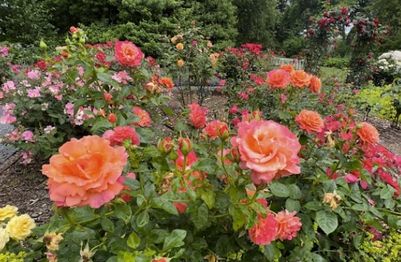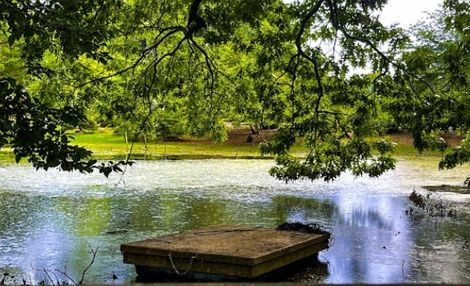
Located in Roslyn Heights on Long Island, New York, Clark Botanic Garden is a stunning botanical garden and park built on a 12-acre land. The garden was founded in 1969. It is an excellent educational facility and live museum dedicated to increasing the knowledge, understanding, and appreciation of plant life worldwide through its horticulture, research, and education practices.
The Clark Botanic Garden includes native plant species like conifers, roses, spring wildflowers, perennials, wetland plants, daylilies, herbs, rock garden plants, and medicinal plants. The collection of more than a dozen plant families also makes the gift shop of Clark Botanic Garden a popular spot for visitors as they offer new and beautiful items regularly, and the shop is open throughout all garden programs.
The Fanny Dwight Clark Memorial Garden, Inc.
This non-profit organization aims to support and preserve the Clark Botanic Garden as a peaceful and serene sanctuary for plant lovers. The organization develops educational programs for visitors of all ages, and the funds generated are donated and used for the garden’s preservation, development, and protection purposes.
The beautiful Clark Botanic Garden was committed to birds, visitors, and plants by Grenville Clark in memory of his wife, Fanny Clark. Their daughter Louisa Clark was a member of the Board. The Garden is maintained by the Town of North Hempstead. They are collaborative partners with Fanny Dwight Clark Memorial Garden, Inc. for the conservation and protection of this space.
Visitor Information

The botanical garden is open for visitors seven days a week. Timings to visit this garden are from 10 am to 6 pm April to October. From November to March, the times are 10 am to 4 pm.
The Clark Botanic Garden gift shop, holding unique and incredible gift items, is open seven days a week from 11 to 3:30 pm. The shop may be closed a week before Christmas or during rough weather.
Clark Botanic Garden is free to enter daily and year-round. However, there is a fee for scheduled events. A voluntary donation is highly appreciated at the time of admittance to the garden.
Rain Garden
The Clark Botanic Garden has a rain garden built in collaboration between the Town of North Hempstead and Sustainable Long Island. The Rain Gardens is an educational tool built on a design that takes advantage of stormwater and rainfall runoff for its plant selection.
The Rain Garden contributes to Clark Botanic Garden’s educational mission and teaches visitors about the importance of rainwater for the growth and nourishment of plants. The rain gardens filter excessive nitrogen from rain and stormwater and replenish the garden’s aquifers. The rain garden is established to educate people to build their rain gardens at home to give better nourishment to their plants.
The plant families that are used to design this rain garden can withstand high amounts of nutrients and moisture, especially phosphorous and nitrogen found in abundance in rainwater.
The plant species in the rain garden will be drought-resistant and perennials, and it is situated on the south side of Clark Botanic Garden. This location helps the rain garden collect stormwater runoff from the gutter system of the garden and from uphill areas lying adjacent to it.
The Pollinator Garden
The pollinator garden was established and certified as a part of the Mayor’s Monarch Pledge. The pollinator garden was certified as having essential resources for the Monarch butterflies, like nectar sources and host plants.
This Monarch Waystation also provides water and a place to rest
The Native Plants Found at Clark Botanic Garden
The rain garden, lower pond, and pollinator garden in Clark Botanic Garden house different native plants that help provide pollen and nectar that benefit pollination. The native plant species in Clark Botanic Garden are:
1. Purple Coneflower
The purple coneflower is not a Long Island native but has now become an excellent nectar source for butterflies and hummingbirds. The purple coneflower blooms in large summer flowers and is a perennial plant. They are a part of many flower gardens since they attract monarchs, swallowtails, and painted ladies to feed on their sweet nectar.
The long-tongued bees or butterflies are the primary pollinators for these flowers because as they sip the nectar, the pollens stick to their legs and bodies, beginning their cross-pollination.
2. False Indigo
It is a group of long-lived perennials with a shrub-like appearance with clusters of dense and deep blue flowers on top of upright spikes. It is native to eastern North American meadows and open woods and provides an excellent pollen and nectar source for native butterflies and bees.
The false indigo is predominantly pollinated by queen bumblebees, which are attracted by its nectar. It is also a great larval host plant for many species like Orange Sulphur, Eastern Tailed-Blue and Hoar Edge butterflies, and queen bumblebees. These insects help pollinate the plant by spreading its sticky pollen.
3. Butterfly Weeds
The stunning flowers of butterfly weed attract butterflies. Butterfly weeds are a plant species native to southwestern and eastern North America. The attractive orange blooms of this milkweed species have bright green foliage and are vital to monarch butterflies.
The reason why this plant supports this declining species is that its larvae feed on these milkweeds. Without these plants, the larva would not develop into an adult, which is why milkweeds are supposed to have evolved along with the most important pollinators of Earth, monarch butterflies.
Are Dogs Welcome at Clark Botanic Garden?
The Clark Botanic Garden was considering making it dog-friendly as the Town Board was scheduled to vote on April 17, 2018. Dogs are welcome to the park, but only if they are kept on a leash and the owners clean up after them.
Conclusion
Clark Botanic Garden is an aesthetic oasis for plant lovers as it features manicured acres of gardens along with ponds, streams, and trees. Enjoy a beautiful day in this botanic garden as you visit its rain and pollinator garden and gain an educational experience that will be knowledgeable for visitors of every age group.
